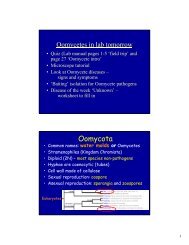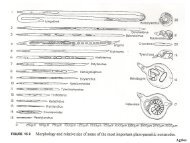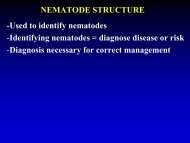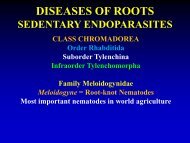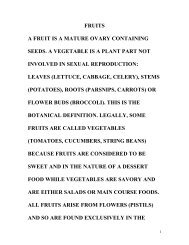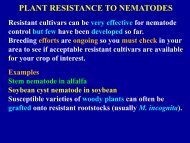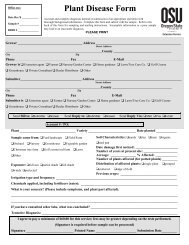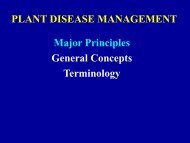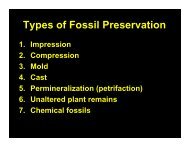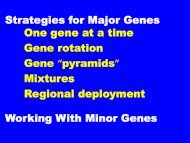Host Pathogen How many races?
Host Pathogen How many races?
Host Pathogen How many races?
Create successful ePaper yourself
Turn your PDF publications into a flip-book with our unique Google optimized e-Paper software.
Gene-for-Gene Hypothesis<strong>Host</strong>RR or R? ? ?<strong>Pathogen</strong>NE, NEorNE, ?? ?PHResistanceHP? ?Disease?Disease?DiseaseSpecific recognition in upper left box only<strong>How</strong> <strong>many</strong> <strong>races</strong>?Three cultivars, each with adifferent R gene yields 8<strong>races</strong> (2 3 )Ten cultivars, each with adifferent R gene coulddiscern a possible 1024<strong>races</strong> (2 10 ) !!The set of cultivars used tocharacterize <strong>races</strong> iscalled a ‘differential set’<strong>Pathogen</strong> race<strong>Host</strong> cultivar1
A common test question:For each of the boxes, indicate whether or notthe <strong>races</strong> of a rust pathogen will succeed ininfecting the host cultivarsNegative effector (N) or lack-of-effector (? or ‘n’) genes possessedResistance (R) orlack-of-resistance (? or ‘r’)genes in each cultivarRace: N 1 N 2 N 3 N 4 N 1 n 2 N 3 N 4 n 1 N 2 N 3 N 4 n 1 n 2 N 3 N 4 n 1 n 2 n 3 n 4r 1 r 2 r 3 r 4R 1 r 2 r 3 r 4r 1 R 2 r 3 r 4R 1 R 2 r 3 r 4R 1 R 2 r 3 R 4‘R’, ‘N’ = active product present ‘?’, ‘n’, ‘r’ = active product absentA common test question:For each of the boxes, indicate whether or notthe <strong>races</strong> of a rust pathogen will succeed ininfecting the host cultivarsNegative effector (N) or lack-of-effector (? or ‘n’) genes possessedResistance (R) orlack-of-resistance (? or ‘r’)genes in each cultivarRace: N 1 N 2 N 3 N 4 N 1 n 2 N 3 N 4 n 1 N 2 N 3 N 4 n 1 n 2 N 3 N 4 n 1 n 2 n 3 n 4r 1 r 2 r 3 r 4R 1 r 2 r 3 r 4r 1 R 2 r 3 r 4R 1 R 2 r 3 r 4R 1 R 2 r 3 R 4yes yes yes yes yesnononononoyesnono‘R’, ‘N’ = active product present ‘?’, ‘n’, ‘r’ = active product absentyesnononoyesyesyesnoyesyesyesyes2
Where do we see R-gene resistance used?Obligate biothrophsrusts (cereals, pine, flax, coffee, corn)smuts (cereals, corn)eastern filbert blight (Oregon hazelnuts)downy mildews (sunflower, lettuce, crucifers)powdery mildews (cereals, cucurbits)viruses (<strong>many</strong> crops)nematodes: sedentary endoparasites (tomato, cereals)Facultative saprophytesapple scabbacterial leaf spots (legumes, cotton, arabidopsis)ascomycete leaf spots (rice, tomato, bean)vascular wilts (crucifers, tomato, banana)oomycetes - root rot (soybean), late blight (potato)Major gene (R-gene)resistance:Upside: Simply Inheritedand Extremely EffectiveRice blastFacultative saprophytePolycyclic disease cycleHigh mutation rate in genomeDownside:It breaks downwhen pathogenloses its elicitorResistancebreakdownRice cultivarscome and goas R-generesistancebreaks down(i.e., stopsmaking the negativeeffector product)= period of time R-gene resistance was effective (i.e., ∆t)3
<strong>Host</strong> resistance & Disease dynamicsQualitative, race-specific R-generesistance is the equivalent ofsanitation:• Reduces initial inoculumbecause only a subset ofpathogen genotypes (in thebeginning, most if not all) arespecifically recognized<strong>Pathogen</strong> populationAfter introduction of the R-gene,the ‘Blue’ race is recognized butred race is not. Frequently, the redrace arises later via mutationDisease severitytimeDisease progresscurve prior toIntroduction of bluerace R-genetDiseaseprogresscurve after red<strong>races</strong> arises<strong>Host</strong> resistance & Disease dynamicsQuantitative, non-race specific resistanceis rate reducing:100%•Reduces the infection rate•Slows how rapidly diseasedevelops•Is effective against allisolates of the pathogen•Generally, it lasts a long timeDisease severityRecall, the late blight epidemiologymovie had in time lapse photographyepidemics showing this resultLow level ofquantitativeresistancetimeHigh level ofquantitativeresistance4
Question: Are there smart ways to deployRace specific resistance?• Gene pyramids• Understand pathogen genetics and itsability to alter/recombine the negativeeffector profile• Increase R-gene diversity in deployedcultivarsSmart deployment of Race specific resistance:R-Gene pyramids(I.e., use of multiple, effectiveR genes simultaneously)R4R6R5Theory: If a mutation from NE1 R1 R2(recognized) to ne1 (i.e., no elicitor)occurs once every 10 8 to 10 10 asexual spores, thena simultaneous mutation from NE 1 ,NE 2 ,…,NE 6 tone 1 ,ne 2 ,…,ne 6 will be a very, very rare event.R3R-Gene pyramids havebeen highly effective forcontrol of cereal rusts5
Smart deployment of race specific resistance:What is this man doing?Hints:• He works for thegovernment• The white stuff isNaCl• The bush is BerberisvulgarisUnderstand pathogen genetics and its ability to recombine the negative effector profileBetween 1918 and 1975, under the direction of the federalgovernment, more than 100 million bushes of Berberis,Mahonia and Mahoberis spp. were killed in 16 Northernwheat-growing states. The program was stopped in 1975.Recently, common barberry has begun a resurgence.6
Understand pathogen genetics and its ability to recombine the negative effector profileStem rust of wheat can turn its primary cycle in two ways:PucciniaPathwayFar enoughsouth, thepathogenoverwintersas myceliuminside ofwheatWhy was/is eradication of barberry so important?Elimination of meiosis greatly(!) slows genesis of new <strong>races</strong>Take home message:Everything else being equal, asexual pathogens are better candidates forsuppression by R-genes than those frequently recombining their genomesIncrease R-gene diversity in deployed cultivars –Cultivar MixturesR1 R2 R2 R1 R2 R1Club wheat mixturein eastern OregonR1, R2 = R-genesMechanisms of suppression:Dilution of inoculumResistant plants are dispersal barriersAvirulent spores induce SARWorks best with polycyclic, foliardiseases of ‘skinny’ plants (rusts orpowdery mildew of cereals)Stripe rust epidemic onsusceptible plantsis slowed by thecultivar mixturePureStandMixture7
Breeding for quantitative, non-<strong>races</strong>pecific resistanceIssues and challenges:Polygenic where each contributing gene has a small effect<strong>How</strong> do we maintain resistance genes in our plantwhere the effects of the individual genes are notreadily observed ?Effective against all isolates of the pathogen<strong>How</strong> can we ensure that this is true?Typically partial resistance without hypersensitive response<strong>How</strong> much disease can we tolerate?Breeding for quantitative, non-race specific resistanceIt is important to expose the potential cultivar tothe extremes of pathogen diversity for a significant period of timeOat crown rust nurseryin MinnesotaOat linesBuckthorn hedges(alternate host forcrown rust)• Oat lines are grown in a ‘pathogen brothel’ toexpose oat breeding lines to maximum diversity• Breeding lines completely resistant or extremelysusceptible are thrown away.• Marker assisted selection helps to maintaineffective genes in breeding line population•Those breeding lines that yield well with a bit ofdisease stay with the program.Telia bearing oat strawon buckthorn hedgeAecial stage on buckthorn8
Summary: Considerations in breedingfor and managing host resistanceAvoiding loss of R-generesistance• pathogen’s life cyclepolycyclic vs monocyclic• pathogen’s geneticsmeiosis, high mutation rates• Longevity of host plant• Ease of deploying multiple R-genesgene pyramidscultivar mixturesMaintaining effective minorgene resistance• continued diligent, fieldbasedscreening andmarker-assisted selectionduring breeding efforts• host exposed to maximumpathogen diversity?• yield/quality evaluated andmaintained under conditionsmost favorable for disease?For more, watch this video titled‘Rust Never Sleeps’http://www.tpt.org/?a=programs&id=21525Also, the following slides were notdiscussed but worth understanding!9
Polygenic (minor gene ) resistance:Plant containingnew R-geneDegree ofResistanceAdaptedLand Cultivar<strong>Pathogen</strong>IsolatesxR-geneTheme: Diligence is neededto maintain minor generesistance at effective levelsDegree ofResistanceFirst generation: EffectiveR-gene resistance ANDpolygenic resistanceContinuedNext slideDegree ofResistanceFive minorgenes<strong>Pathogen</strong>Isolates<strong>Pathogen</strong>IsolatesWhen the 1 st generation plant is screenedfor resistance, the highly effectiveintroduced R-gene will mask the level ofminor gene resistance in the new host lineDegree ofResistancePolygenic (minor gene) resistance:Theme: It is hard to hang on to effectiveminor gene resistanceFirst generation: EffectiveR-gene resistance ANDeffective polygenic resistance<strong>Pathogen</strong>IsolatesContinueResistanceScreeningAnd CrossingAnd SelectionxOther (susceptible)parents with traitsto address additionalgoals of the programProud parent day:Released diseaseresistantcultivar:Degree ofResistance<strong>Pathogen</strong>Isolates2 yearslater anewraceariseswipeoutBut , polygenic resistance has“eroded” with each crossinggeneration because its effectswere masked by the R-gene.In literature, this is called the‘Vertifolia effect’ after a potatocultivar where this occurred10



